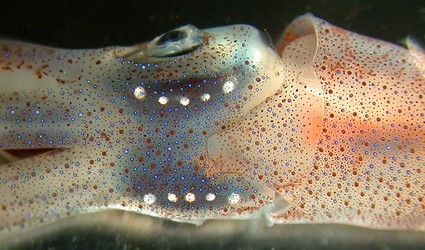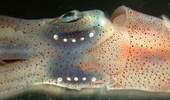Abraliopsis (Abraliopsis)
Richard E. Young.png?x=-1358257914)


This tree diagram shows the relationships between several groups of organisms.
The root of the current tree connects the organisms featured in this tree to their containing group and the rest of the Tree of Life. The basal branching point in the tree represents the ancestor of the other groups in the tree. This ancestor diversified over time into several descendent subgroups, which are represented as internal nodes and terminal taxa to the right.

You can click on the root to travel down the Tree of Life all the way to the root of all Life, and you can click on the names of descendent subgroups to travel up the Tree of Life all the way to individual species.
For more information on ToL tree formatting, please see Interpreting the Tree or Classification. To learn more about phylogenetic trees, please visit our Phylogenetic Biology pages.
close boxIntroduction
Species of Abraliopsis (Abraliopsis), with the exception of A. (Boreabraliopsis) felis, are recognized by their scattered photophore patterns of both complex and non-complex photophores. Their differences with A. felis are given on the A. (B.) felis page. Within the scattered arrangement there may be subtle patterns that are difficult to recognize which makes species identification mostly dependent on non-photophore characters.Characteristics
The relationships of the species of Abraliopsis (Abraliopsis) is summarized in the following table.
| A. pacificus | A. tui | A. sp. B | A. sp. NC4 | A. morisii | A. hoylei | A. sp. Z | |
| Distribution | Subtropical northwestern Pacific | Subtropical Pacific near New Zealand | Tropical central Pacific | Tropical Pacific near New Caledonia | Tropical-temperate Atlantic | Tropical Indian Ocean | Subtropical, temperate South Atlantic |
| Dorsal flap on hectocotylus | Yes | No | No | Yes | Yes | ? | No |
| Arms IV length index (=%MLx100) | x̅ = 68 | 100-110 | x̅ = 74 | x̅ = 90 | ca. 70-90 | 75 (?) | ~80 |
| Median Mantle Sector with bare-strip indistinct in anterior 1/5 of mantle. | Yes | No | Yes | Yes | Yes | Yes | No |
| 1st Lateral Window Series with gap | Yes, but minor | ? | Yes, but minor | Yes, but minor | No | ? | No |
| Second lateral window series present | Yes (28 mm ML) | ? | No (26 mm ML) | No (26 mm ML) | Yes (25 mm ML) | ? | Yes, but large gap. (29 mm ML) |
| Lateral Funnel-Groove series | 2+2, non-overlaping (28 mm ML) | ? | 2+2, non-overlaping (26 mm ML) | 2+2, non-overlaping (26 mm ML) | 4+2, overlapping (at 35 mm) | ? | 3+3, non-overlapping (29 & 35 mm ML) |
| Olfactory Photophore/Series | Red/Absent (28 mm ML) | ? | Blue/Absent (26 mm ML) | Red/Absent (26 mm ML) | Blue/absent (35 mm ML) | ? | Red/present (29 mm ML) |
| Head width index (=%MLx100) | Males: x̅ = 35 Females: x̅ = 33 | ? | Males: x̅ = 45 Females: x̅ = 41 | ? | Females: x̅ = 40 | ? | x̅ = 39 combined sexes |
| Distinct posterior crescent ridge connects occipital folds 3 and 4 | No | Yes | No | Yes | Yes | ? | Yes |
| Fin width index (=%MLx100) | x̅ = 92 | 101-111 | x̅ = 106 | x̅ = 100 | ? | 95 | 100 |
| No. arm IV hooks | x̅ = 21 | 17-23 | x̅ =12.5 (11-14) | x̅ = 18.8 (16-21) | ? | 19-21 (?) | 18; 20 (hecto) |
| Length: sperm mass/spermatophore | 0.15 | 0.4 | 0.25 | ||||
| Lateral head sector, red photophores * | 5-7 (28 mm ML) | ? | 6 (26 mm ML) | 0-1 (26 mm ML) | 9-11 (25 mm ML) | ? | Not Applicable |
x̅ = "x-bar" = mean
* - Difficult character to use as Sectors are somewhat arbitrary and number of red photophores is dependent on size as well as species.Comments
This table indicates that the presence or absence of a dorsal flap on the hectocotylus is a critical character in identifying species. Unfortunately it can be a difficult character to recognize if squid are not in very good condition. The two species (A. tui and A. sp. B) that lack a dorsal flap are easily separated by the several characters of which (1) the number of hooks on arms IV and (2) the median strip bare of photophores in the anterior 1/5 of the mantle (most/all species have a bare strip in the posterior 2/3 of the mantle). A. sp. B is also distinctive in having a very broad head which is easily recognized (see the top title photograph on this page).
Among the 4 species that have a dorsal flap on the hectocotylus, A. sp. Z is easily recognized by (1) the greater abundance and distinctive arrangement of head photophores and (2) the median strip bare of photophores in the anterior 1/5 of the mantle. The remaining three are more difficult. A. sp. NC4 is separated from A. pacificus and A. morisii by the number of red photophores present in the lateral head sector. The latter two species can be separated by (1) the color of the olfactory photophore at least between 28 and 35 mm ML and (2) their habitat. A. hoylei cannot be identified at present; its identity must wait until we know what species of Abraliopsis occur at its type locality.
Unlike members of subgenera Pfefferiteuthis and Micrabralia the club membranes and hook-sizes appear to be similar in all members of the subgenus Abraliopsis.
Title Illustrations

| Scientific Name | Abraliopsis sp. B |
|---|---|
| Location | Hawaiian waters |
| Specimen Condition | Dead Specimen |
| Sex | Male |
| Life Cycle Stage | Mature |
| View | Ventral |
| Size | 20 mm ML |
| Image Use |
 This media file is licensed under the Creative Commons Attribution License - Version 3.0. This media file is licensed under the Creative Commons Attribution License - Version 3.0.
|
| Copyright |
©
Richard E. Young

|
| Scientific Name | Abraliopsis morisii |
|---|---|
| Location | North Atlantic, 43°N, 28°W |
| Comments | Photographed aboard the R/V G.O. SARS, during the MAR-ECO expedition 2004 |
| Specimen Condition | Fresh |
| Body Part | Photophore arrangement on head and mantle |
| View | Ventral |
| Image Use |
 This media file is licensed under the Creative Commons Attribution-NonCommercial License - Version 3.0. This media file is licensed under the Creative Commons Attribution-NonCommercial License - Version 3.0.
|
| Copyright |
©
Richard E. Young

|
About This Page
Richard E. Young

University of Hawaii, Honolulu, HI, USA
Correspondence regarding this page should be directed to Richard E. Young at
dickphyllisyoung@gmail.com
Page copyright © 2014 Richard E. Young
 Page: Tree of Life
Abraliopsis (Abraliopsis).
Authored by
Richard E. Young.
The TEXT of this page is licensed under the
Creative Commons Attribution-NonCommercial License - Version 3.0. Note that images and other media
featured on this page are each governed by their own license, and they may or may not be available
for reuse. Click on an image or a media link to access the media data window, which provides the
relevant licensing information. For the general terms and conditions of ToL material reuse and
redistribution, please see the Tree of Life Copyright
Policies.
Page: Tree of Life
Abraliopsis (Abraliopsis).
Authored by
Richard E. Young.
The TEXT of this page is licensed under the
Creative Commons Attribution-NonCommercial License - Version 3.0. Note that images and other media
featured on this page are each governed by their own license, and they may or may not be available
for reuse. Click on an image or a media link to access the media data window, which provides the
relevant licensing information. For the general terms and conditions of ToL material reuse and
redistribution, please see the Tree of Life Copyright
Policies.
- First online 03 November 2013
- Content changed 03 November 2013
Citing this page:
Young, Richard E. 2013. Abraliopsis (Abraliopsis). Version 03 November 2013 (under construction). http://tolweb.org/Abraliopsis_%28Abraliopsis%29/149532/2013.11.03 in The Tree of Life Web Project, http://tolweb.org/







 Go to quick links
Go to quick search
Go to navigation for this section of the ToL site
Go to detailed links for the ToL site
Go to quick links
Go to quick search
Go to navigation for this section of the ToL site
Go to detailed links for the ToL site